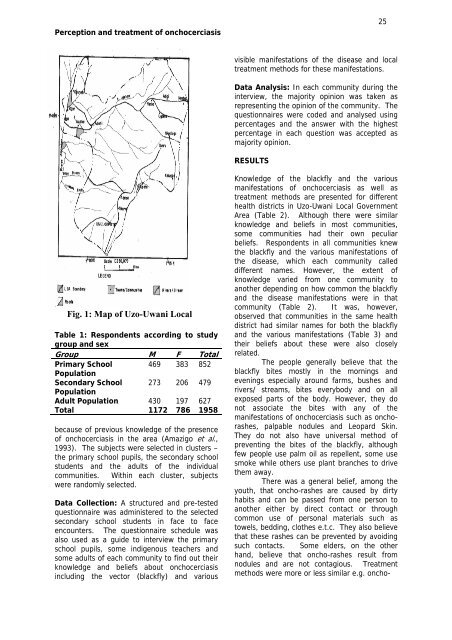Length-weight relationship of fishes from Anambra ... - Zoo-unn.org
Length-weight relationship of fishes from Anambra ... - Zoo-unn.org
Length-weight relationship of fishes from Anambra ... - Zoo-unn.org
- No tags were found...
Create successful ePaper yourself
Turn your PDF publications into a flip-book with our unique Google optimized e-Paper software.
Perception and treatment <strong>of</strong> onchocerciasis25visible manifestations <strong>of</strong> the disease and localtreatment methods for these manifestations.Data Analysis: In each community during theinterview, the majority opinion was taken asrepresenting the opinion <strong>of</strong> the community. Thequestionnaires were coded and analysed usingpercentages and the answer with the highestpercentage in each question was accepted asmajority opinion.RESULTSFig. 1: Map <strong>of</strong> Uzo-Uwani LocalTable 1: Respondents according to studygroup and sexGroup M F TotalPrimary School 469 383 852PopulationSecondary School 273 206 479PopulationAdult Population 430 197 627Total 1172 786 1958because <strong>of</strong> previous knowledge <strong>of</strong> the presence<strong>of</strong> onchocerciasis in the area (Amazigo et al.,1993). The subjects were selected in clusters –the primary school pupils, the secondary schoolstudents and the adults <strong>of</strong> the individualcommunities. Within each cluster, subjectswere randomly selected.Data Collection: A structured and pre-testedquestionnaire was administered to the selectedsecondary school students in face to faceencounters. The questionnaire schedule wasalso used as a guide to interview the primaryschool pupils, some indigenous teachers andsome adults <strong>of</strong> each community to find out theirknowledge and beliefs about onchocerciasisincluding the vector (blackfly) and variousKnowledge <strong>of</strong> the blackfly and the variousmanifestations <strong>of</strong> onchocerciasis as well astreatment methods are presented for differenthealth districts in Uzo-Uwani Local GovernmentArea (Table 2). Although there were similarknowledge and beliefs in most communities,some communities had their own peculiarbeliefs. Respondents in all communities knewthe blackfly and the various manifestations <strong>of</strong>the disease, which each community calleddifferent names. However, the extent <strong>of</strong>knowledge varied <strong>from</strong> one community toanother depending on how common the blackflyand the disease manifestations were in thatcommunity (Table 2). It was, however,observed that communities in the same healthdistrict had similar names for both the blackflyand the various manifestations (Table 3) andtheir beliefs about these were also closelyrelated.The people generally believe that theblackfly bites mostly in the mornings andevenings especially around farms, bushes andrivers/ streams, bites everybody and on allexposed parts <strong>of</strong> the body. However, they donot associate the bites with any <strong>of</strong> themanifestations <strong>of</strong> onchocerciasis such as onchorashes,palpable nodules and Leopard Skin.They do not also have universal method <strong>of</strong>preventing the bites <strong>of</strong> the blackfly, althoughfew people use palm oil as repellent, some usesmoke while others use plant branches to drivethem away.There was a general belief, among theyouth, that oncho-rashes are caused by dirtyhabits and can be passed <strong>from</strong> one person toanother either by direct contact or throughcommon use <strong>of</strong> personal materials such astowels, bedding, clothes e.t.c. They also believethat these rashes can be prevented by avoidingsuch contacts. Some elders, on the otherhand, believe that oncho-rashes result <strong>from</strong>nodules and are not contagious. Treatmentmethods were more or less similar e.g. oncho-

















